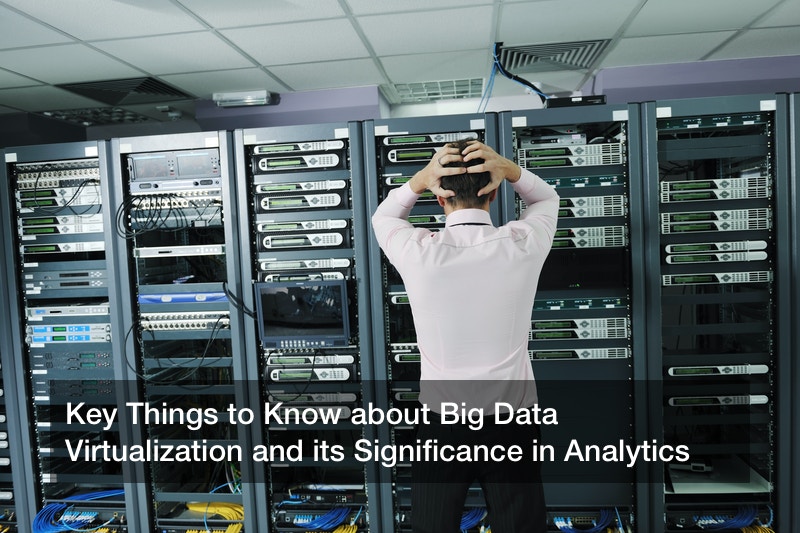Key Things to Know about Big Data Virtualization and its Significance in Analytics

Solving the challenges of big data needs the users to hand huge volumes of data sets which are distributed in a diversified manner. This needs to be paired with data-intensive and high-computing applications to be optimally effective. Data virtualization further provides an additional layer of efficiency and makes big data analytics a reality. Even though virtualization is not an essential big data requirement; technically, the software frameworks are found to be highly efficient in a complexly virtualized environment.
At the baseline, there are three major characteristics for virtualization which support operational efficiency and scalability of a big data environment. These are;
- Partitioning: In terms of data virtualization, there are different operating systems and applications coming as a part of it, which all are supported using a single system by enabling partitioning of the available resources.
- Isolation: In terms of isolation, each of the virtual machines is getting isolated from the physical host system and other virtual machines. As a part of isolation, even if there is one virtual instance, there could be other virtual machines as well as the host systems, which may not be affected. Moreover, the data also isn’t shared between the virtual instances.
- Encapsulation: This is another virtual machine, which represents only a unique file so that the users can easily identify it based on services which it may provide.
Server virtualization in big data
In terms of server virtualization, there could be only one server physically, which is further partitioned to act as many virtual servers for data management. The resources and hardware elements of the server machine as:
- Random Access Memory
- Central Processing Unit
- Hard drive
- Network controller etc. can be virtualized into a set of virtual machines, which each should run its own application.
Virtual machine or VM is actually software representing a machine itself which can perform similar functions as a physical machine. There could also be a single-layer code which contains a monitor for virtual machine otherwise called a hypervisor. As pointed out by RemoteDBA.com, doing server virtualization will further use the hypervisor to offer more efficiency in terms of using the available physical resources. The installation, as well a configuration and upkeep of servers, are arranged using these virtual machines.
Doing server and data virtualization will let the users and stakeholders make sure that it will help to ensure that the data platforms could further scale up or down based on their need to handle the varied and large type of data for analysis. An individual may not understand the needed volume and extent of the business before you do any such analysis. Such uncertainty in place further demands server virtualization for better process and providing the environment to meet the demands of handling and processing some huge data sets.
Adding to it, the process of server and data virtualization will also provide a solid foundation to the behavioral databases, which will enable any of the cloud services to use that data as DAAS in big data analysis. Virtualization will also help enhance the efficiency of the cloud, which will ultimately make a complete big data system which is easier to optimize and interpret.
Virtualization of Big data application
Virtualization of the big data application infrastructure will further provide a highly efficient environment to manage data-intensive applications based on customer demand. All these applications can be encapsulated in such a way that it removes any difficulties form the computer system which is physically set. This approach will help to improve the overall manageability of the big data application.
Adding to it, the infrastructure virtualization of the software application may also allow better codifying the technical and business policies in order to ensure that such big data applications can rightly leverage the physical and virtual resourced in a much predictable manner and get the best output. Such systems gain efficiency by distributing the IT resources in the system based on the need for the value of the relative business of your business applications.
Virtualization of the application infrastructure combined with server virtualization may help the users to make sure that all service-level agreements are fulfilled. Virtualization of the CPU, memory use, and CPU all by accounting for the variations in business priorities is important while allocating the technical resources.
Virtualization of big data networks
The concept of network virtualization is all about finding out the most effective way to use networking resources as a common pool of connected resources. Unlike the approach of relying on the physical network to manage the traffic, users can create many virtual networks which commonly use the same implementation physically.
This may be useful once if you need to define a data network with a set of unique performance capacity and characteristics against another application network which has a different capacity and performance level. Virtualization of data networks also helps in reducing any bottleneck in terms of performance and also help improve the manageability of large distributed data sets as in case of typical big data analysis.
Memory virtualization and virtualization of big data processors
You can do processor virtualization in big data systems, which will help in optimizing the processor performance and maximizing the output. When done effectively, memory virtualization can decouple the memory from servers and function as a standalone entity for better performance. In the case of big data analysis, one can have repeated queries also for the large data sets in question and about the creation of some advanced algorithms for analytics.
All these systems are designed to check for any common patterns or trends which are not understood by the users. However, such advanced analytical systems need more processing power and also better memory capacities. Such computations may take a longer time if there is no sufficient memory and CPU resources are allocated.
Virtualization of data can also be used in order to create the platforms for linked data services. This approach will let the users to easily search for data and get it linked through a unique source for reference. With this, data virtualization will ultimately offer abstract services which are capable of delivering data regardless of the structure of the physical database lies beneath. Adding to it, data virtualization may also expose the cached data to applications across the network and help improve individual performance.



